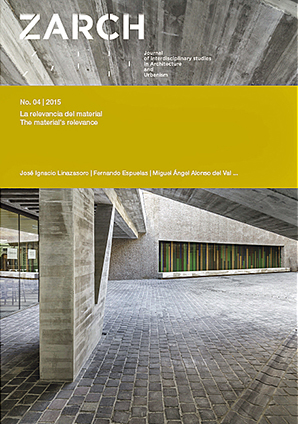Eleven words to approach glass
DOI:
https://doi.org/10.26754/ojs_zarch/zarch.201549162Keywords:
Frontier, Glass, Light, Graze, Transparency, ReflectanceAbstract
This paper focuses on one of the substances that has contributed, particularly in the last two centuries, in an ambiguous, complex and elusive way, to the construction of that what Heidegger calls “Frontiers”: Glass. It explores how those glass frontiers, thanks to their optical properties (the interaction of light and gaze with glass as a mediator between the two), contribute to trigger a series of situations, phenomena and feelings that exceed the study of the material from a purely scientific point of view. We have chosen to reflect over eleven words (phantasmagoria, estrangement, hierarchy, intimacy, seduction, absorption, silence, time, dematerialization, materialization, invisibility). This discussion is accompanied by a series of pictures and film frames that express how architecture makes use of some of the most ungraspable qualities of this paradoxical material, namely, transparency and reflectance. These properties are sometimes used in a premeditated manner and sometimes unexpectedly. Glass is a medium that expresses or reflects certain human conditions, thus exceeding the mere physical nature of the material.
Display downloads
References
ASHBY, Michael F., PAULO J. FERREIRA, and Daniel L. SCHODEK. Nanomaterials, Nanotechnology and Design: an Introduction for Engineers and Architects. Burlington: Elsevier, 2009.
BACHELARD, Gaston. La poética del espacio, 3ª ed. Buenos Aires: Fondo de cultura económica de Argentina, 1992.
BARTHES, Roland. La cámara lúcida: nota sobre fotografía, 5ª ed. Barcelona: Paidós, 2006.
BARRAGÁN, Luis. Escritos y conversaciones. El Escorial: El croquis editorial, 2000.
BAUDRILLARD, Jean. Las estrategias fatales. Barcelona: Anagrama, 1984.
BORGES, Jorge Luis. El libro de los Seres Imaginarios. Barcelona: Editorial Bruguera, 1979
CAGE, John. A Year from Monday. Middletown: Wesleyan University Press, 1961.
____. Silencio. Madrid: Árdora ediciones, 2005.
HAN, Byung-Chul. La sociedad de la transparencia. Barcelona: Herder Editorial, 2013.
HEIDEGGER, Martin. “Construir, habitar, pensar”. En Conferencias y artículos. Traducido por Eustaquio Barjau. Barcelona: Serbal, 1994.
FURJÁN, Helene. “The Specular Spectacle of the house of the collector”. Assemblage 34 (Dec. 1997): 56-91.
GARCÍA FERNÁNDEZ, Carlos. “Pescile (In) material”. Arquitectura: Revista del COAM 365 (2012): 34-35.
ITO, Toyo. Escritos. Murcia: Colegio de Aparejadores, 2000.
JOSEPH, Branden W. “John Cage and the Architecture of Silence”. October Magazine 81 (Summer, 1997):81-104.
MAILLET, Arnaud. The Claude Glass. Use and Meaning of the Black Mirror in Western Art. New York: Zone Books, 2004.
MELCHIOR-BONNET, Sabine. Historia del espejo. Barcelona: Herder, 1996.
MOHOLY-NAGY, Lázsló. The New Vision. New York: George Wittenborn, 1947.
ROBBE-GRILLET, Alain. El año pasado en Marienbad. Barcelona: Seix Barral, 1962.
SCHULMAN, Julius. The photography of architecture and design: photographing buildings, interiors, and the visual arts. New York: Whitney Library of Design, 1977.
SONTAG, Susan. Sobre la fotografía. Barcelona: Edhasa, 1996.
TERESA DE JESÚS. Las Moradas. Madrid: Espasa Calpe, 1981.
TIE JUN CUI, David R. SMITH and Ruopeng LIU, ed. Metamaterials. Theory, Design and Applications. New York: Springer, 2010.
VIDLER, Anthony. “Transparency” en The Architectural Uncany. Essays in the Modern Unhomely. Cambridge: The MIT Press, 1992.
VITRUBIO Polión, Los Diez libros de arquitectura. Traducido por José Ortiz y Sanz. Madrid: Akal, 1987.
WARBURG, Aby. Atlas Mnemosyne. Barcelona: Ediciones Akal, 2010.





